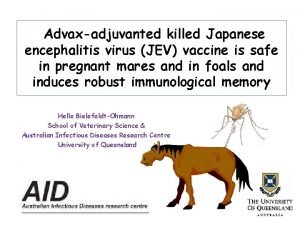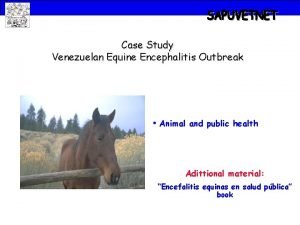Eastern Equine Encephalitis in Maine 2009 2010 Sara

- Slides: 1

Eastern Equine Encephalitis in Maine, 2009 -2010 Sara Robinson, 1 MPH , Charles 2, Lubelczyk Lee 3 Kantar 1 Maine Center for Disease Control and Prevention 2 Maine Medical Center Research Institute 3 Maine Department of Inland Fisheries & Wildlife BACKGROUND Eastern Equine Encephalitis (EEE) is a rare but serious arboviral disease that affects humans. This virus is directly transmitted through the bite of an infected mosquito. Approximately 1/3 of all people who acquire this disease will die, and a remaining 1/3 will have long term neurological problems. In 2009, Maine experienced a EEE outbreak among non-humans including 15 horses, 1 llama, 3 flocks of pheasants and 2 pools of mosquitoes. The outbreak in 2009 demonstrated a wider geographical range than was previously expected. Maine CDC partnered with federal CDC and Maine Medical Center Research Institute (MMCRI)’s vector borne laboratory to determine the geographical extent of EEE in Maine by conducting a deer and moose serosurvey. METHODS During the fall of 2009 and 2010 volunteers staffed tagging stations across the state. In 2009 sampling was limited to white tailed deer, but in 2010 sampling increased to include moose. Volunteers took samples of blood from the animal’s body cavity, or extracted blood from the heart if available, and had the hunter mark the spot of the kill on a map. RESULTS – 2009 AND 2010 RESULTS – COMBINED 2009 AND 2010 In 2009, 226 deer were sampled and 20 tested positive for EEE (8. 85%). Maine 2009 Androscoggin Cumberland Kennebec Knox Lincoln Oxford Penobscot Somerset Waldo York Unknown # deer tested 2 53 52 5 1 1 8 21 38 19 26 # deer positive 0 5 3 0 0 0 1 5 5 1 0 Percentage (deer pos/deer tested) 0 9. 4 5. 8 0 0 0 12. 5 23. 8 13. 2 5 0 In 2010, 335 deer were sampled and 45 tested positive for EEE (13. 6%); and 145 moose were sampled with 15 testing positive for EEE (10. 3%). Maine 2010 Androscoggin Aroostook Cumberland Franklin Kennebec Knox Lincoln Oxford Penobscot Piscataquis Sagadahoc Somerset Waldo Washington York # deer tested 19 15 41 2 73 1 1 1 23 2 10 35 54 20 35 # deer positive 1 1 3 0 9 0 0 0 5 2 1 10 12 0 1 Percentage (deer pos/deer tested) 5. 3 6. 7 7. 3 0 12. 3 0 0 0 21. 7 100 10 28. 6 22. 2 0 2. 9 # moose tested # moose positive Percentage (moose pos/moose tested) 125 12 9. 6 • Samples were collected from 15 of Maine’s 16 counties • Positives were found in 10 counties • Overall 11. 6 percent of deer were positive • Overall 10. 3 percent of moose were positive • 2 bears were tested, neither were positive 2 1 50 18 2 11. 1 All non-human cases of Eastern Equine Encephalitis – New England, 2009 and 2010 Federal CDC analyzed the blood samples for EEE by Plaque Reduction Neutralization Test (PRNT), and geocoded the location of the kill. Combined 2009 and 2010 data: CONCLUSIONS Through this serosurvey project we learned that the risk area for EEE is far larger than originally thought. This information allowed Maine CDC to expand our educational efforts statewide. The 2011 serosurvey began 10/29/2011 with hopes to expand coverage in Aroostook county, the Down-East area, and the Western areas of the state. A 2012 survey is planned as well. MORE INFORMATION More information on Eastern Equine Encephalitis in Maine: http: //www. maine. gov/dhhs/boh/ddc/epi/vector-borne/eee/index. shtml Gibney et al. “Eastern Equine Encephalitis: An Emerging Arboviral Disease Threat, Maine, 2009. Vector-Borne and Zoonotic Diseases. Vol 11 Number 6, 2011 (637 -639). Mutebi et al. “Using Wild White-Tailed Deer to Detect Eastern Equine Encephalitis Virus Activity in Maine. ” Vector-Borne and Zoonotic Disease. Vol 11, Number 10, 2011 (1403 -9)

